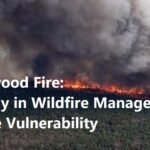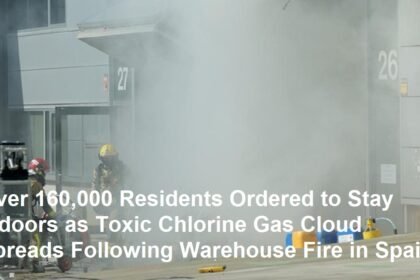A devastating wildfire erupted in central Israel on [insert date], rapidly spreading across dry landscapes and threatening communities near Jerusalem. The inferno, fueled by strong winds and prolonged drought conditions, forced authorities to shut down Route 38—a critical highway linking central Israel to Jerusalem—and evacuate thousands of residents from the towns of Eshtaol, Beit Meir, and Meshilat Zion. Firefighters, aided by aerial support, are battling relentlessly to contain the flames as the crisis enters its second day.
Rapid Spread and Immediate Threats
The fire began in a forested area near the city of Beit Shemesh, approximately 30 kilometers west of Jerusalem. Within hours, gusty winds propelled the blaze eastward, encroaching on the outskirts of Jerusalem and sending thick plumes of smoke over the holy city. By evening, the flames had reached the Jerusalem Corridor, a region dotted with residential communities and forests, prompting urgent evacuations.
Israeli police swiftly closed Route 38, a major artery for commuters and commercial traffic, to prevent civilian entry into danger zones. “The situation is dynamic and extremely dangerous,” stated Police Commissioner Yaakov Shabtai. “Our priority is saving lives, not property.”
Mass Evacuations and Emergency Response
Residents of Eshtaol, Beit Meir, and Meshilat Zion—small towns nestled in the Judean Hills—were ordered to leave their homes as flames advanced. Emergency services deployed buses and military vehicles to assist evacuations, while community centers in Jerusalem and Modiin were converted into temporary shelters.
“No one expected it to move this fast,” said Miriam Cohen, a Beit Meir resident. “We grabbed documents and pets and left. The sky was orange.”
Over 1,000 firefighters, including volunteers from across Israel, are combating the blaze alongside aircraft dropping fire retardants. The Israel Defense Forces (IDF) also mobilized engineering units to clear flammable vegetation and create firebreaks. However, rugged terrain and limited access to some areas have hampered efforts.
Environmental and Regional Impact
The wildfires have consumed over 10,000 acres of forest and scrubland, raising concerns about long-term ecological damage. The Jerusalem Pine forests, a hallmark of the region, are particularly vulnerable. Environmental groups warn that recovery could take decades.
Meanwhile, air quality in Jerusalem and nearby cities has plummeted to hazardous levels, with health officials urging vulnerable populations to stay indoors. The fires have also reignited debates about Israel’s preparedness for climate-driven disasters, as temperatures in the region have soared above 40°C (104°F) this week, exacerbating dry conditions.
Investigations and Regional Solidarity
While the cause remains under investigation, officials have not ruled out arson. Wildfires in Israel are often politicized, with past incidents linked to negligence or deliberate acts amid regional tensions. Prime Minister Benjamin Netanyahu convened an emergency cabinet meeting, pledging “all necessary resources” to address the crisis.
International aid has begun pouring in, with Greece, Cyprus, and Italy dispatching firefighting planes. The Palestinian Authority also offered assistance, marking a rare moment of cooperation amid ongoing political strife.
Ongoing Challenges and Future Concerns
As night fell, firefighters warned that shifting winds could push flames toward additional communities. Authorities are preparing for potential evacuations in Beit Shemesh and Tzur Hadassah if conditions worsen.
The closure of Route 38 has disrupted travel and commerce, underscoring the fire’s broader economic impact. Meanwhile, evacuated residents face an uncertain wait. “We don’t know if our homes will survive,” said David Levi of Eshtaol. “But we’re alive—that’s what matters.”
The wildfires serve as a stark reminder of the escalating threats posed by climate change in the Mediterranean region. As Israel battles this disaster, the resilience of its emergency response systems and the solidarity of its people—and neighbors—will be tested. For now, the nation holds its breath, hoping for rain, respite, and a path to recovery.









